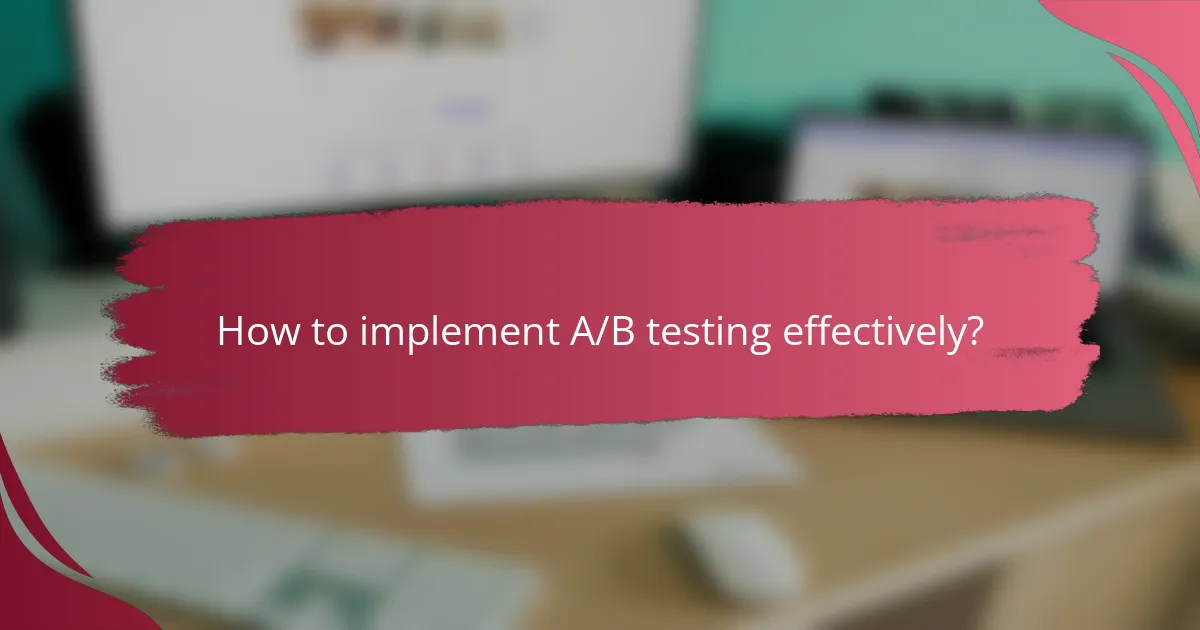A/B testing is a powerful methodology in marketing that enables businesses to compare two versions of a campaign to identify which one yields better results. By optimizing marketing strategies through data-driven insights, A/B testing enhances overall effectiveness and efficiency. To successfully implement this approach, it’s essential to set clear goals and utilize the right tools, such as Optimizely or Google Optimize, to facilitate the testing process.

What are the benefits of A/B testing in marketing?
A/B testing in marketing offers significant advantages by allowing businesses to compare two versions of a campaign to determine which performs better. This method helps optimize marketing strategies, leading to increased effectiveness and efficiency.
Improved conversion rates
One of the primary benefits of A/B testing is the potential for improved conversion rates. By testing variations of landing pages, emails, or advertisements, businesses can identify which elements drive more users to complete desired actions, such as making a purchase or signing up for a newsletter.
For instance, a simple change in a call-to-action button’s color or text can lead to a noticeable increase in conversions, often in the range of 10-30%. Regularly conducting A/B tests ensures that marketing efforts are continually refined for maximum impact.
Enhanced user experience
A/B testing contributes to an enhanced user experience by allowing marketers to understand what resonates with their audience. By analyzing user interactions with different content or layouts, businesses can create a more engaging and intuitive experience.
For example, testing different navigation structures on a website can reveal which layout keeps users on the site longer. This not only improves user satisfaction but can also lead to higher retention rates and repeat visits.
Data-driven decision making
Utilizing A/B testing fosters data-driven decision making, enabling marketers to base their strategies on actual user behavior rather than assumptions. This empirical approach reduces guesswork and helps in making informed choices that align with audience preferences.
Marketers can track metrics such as click-through rates and engagement levels, allowing them to pivot strategies based on solid evidence. This process leads to more effective campaigns and better resource allocation.
Cost-effective optimization
A/B testing is a cost-effective method for optimizing marketing efforts. By identifying the most effective strategies early, businesses can allocate their budgets more wisely, focusing on high-performing campaigns.
For example, if an A/B test shows that one ad version significantly outperforms another, resources can be redirected to amplify that successful campaign. This approach minimizes wasted spend on ineffective strategies.
Reduced risks in changes
Implementing changes in marketing strategies can be risky, but A/B testing mitigates this risk. By testing changes on a smaller scale before a full rollout, businesses can gauge the impact without committing extensive resources upfront.
This method allows for gradual adjustments based on user feedback, ensuring that significant changes are well-received. For instance, a company can test a new pricing strategy with a small segment of its audience before applying it broadly, reducing the likelihood of negative backlash.

How to implement A/B testing effectively?
To implement A/B testing effectively, start by establishing clear goals and a structured approach. This ensures that your tests yield actionable insights and drive meaningful improvements.
Define clear objectives
Defining clear objectives is crucial for successful A/B testing. Objectives should be specific, measurable, and aligned with your overall business goals. For instance, you might aim to increase conversion rates by a certain percentage or improve user engagement metrics.
Consider using the SMART criteria (Specific, Measurable, Achievable, Relevant, Time-bound) to formulate your objectives. This clarity helps in designing tests that are focused and relevant.
Choose the right metrics
Selecting the right metrics is essential to evaluate the success of your A/B tests. Common metrics include conversion rates, click-through rates, and average order value. Choose metrics that directly relate to your objectives for a clearer assessment of outcomes.
It’s also important to avoid vanity metrics that do not provide actionable insights. Focus on metrics that reflect user behavior and business impact, ensuring they align with your defined objectives.
Segment your audience
Segmenting your audience allows for more targeted A/B testing, leading to more relevant results. You can segment by demographics, behavior, or user journey stages to tailor your tests to specific groups.
For example, testing a new feature on first-time visitors versus returning customers can yield different insights. This approach helps in understanding how different segments respond to changes, enabling more personalized strategies.
Run tests for sufficient duration
Running tests for a sufficient duration is vital to gather reliable data. A/B tests should typically run for at least one to two weeks to account for variations in user behavior across different days and times.
Avoid making premature conclusions based on short testing periods, as this can lead to misleading results. Ensure you have enough data to achieve statistical significance, which can typically be assessed using online calculators or statistical software.

What tools are available for A/B testing?
Several tools are available for A/B testing, each offering unique features to help optimize web performance and user experience. Popular options include Optimizely, Google Optimize, VWO, and Adobe Target, which cater to different needs and budgets.
Optimizely
Optimizely is a leading A/B testing platform known for its user-friendly interface and robust experimentation capabilities. It allows users to create and run tests without extensive coding knowledge, making it accessible for marketers and product teams alike.
Key features include multivariate testing, personalization, and analytics integration. Optimizely is particularly effective for larger organizations looking to scale their testing efforts across multiple channels.
Google Optimize
Google Optimize is a free tool that integrates seamlessly with Google Analytics, making it an excellent choice for those already using Google’s ecosystem. It supports A/B testing, multivariate testing, and redirect tests, allowing users to experiment with various elements on their websites.
While it offers a solid range of features, its capabilities may be limited compared to paid solutions. However, for small to medium-sized businesses, it provides a cost-effective way to start A/B testing.
VWO
VWO (Visual Website Optimizer) combines A/B testing with additional features like heatmaps and session recordings, providing a comprehensive view of user behavior. This tool is designed for marketers who want to understand how changes impact user engagement and conversion rates.
VWO’s intuitive visual editor allows users to make changes without coding, and its robust reporting features help track the performance of tests effectively. It’s suitable for businesses looking for an all-in-one solution for website optimization.
Adobe Target
Adobe Target is part of the Adobe Experience Cloud and offers advanced A/B testing capabilities along with personalization features. It is designed for enterprises that require a high level of customization and integration with other Adobe products.
With Adobe Target, users can create sophisticated tests and deliver personalized experiences based on user segments. However, its complexity and pricing may be more suited for larger organizations with dedicated resources for digital marketing.

What are the common mistakes in A/B testing?
Common mistakes in A/B testing can lead to inaccurate results and wasted resources. Key pitfalls include testing too many variables at once, ignoring statistical significance, and failing to define clear success criteria.
Testing too many variables
Testing multiple variables simultaneously can complicate results and make it difficult to identify which changes influenced performance. It’s advisable to focus on one or two variables at a time to isolate their effects clearly.
For example, if you change the color of a button and the text simultaneously, you won’t know which change drove any observed differences in user behavior. Stick to a simple approach to ensure clarity in your findings.
Ignoring statistical significance
Ignoring statistical significance can lead to false conclusions about the effectiveness of a test. It’s crucial to use appropriate statistical methods to determine whether the results are due to chance or represent a real effect.
Typically, a p-value of less than 0.05 is considered statistically significant. This means that there’s less than a 5% chance that the observed differences occurred randomly. Always calculate this before making decisions based on A/B test results.
Not defining success criteria
Failing to define success criteria before starting an A/B test can result in ambiguity and misinterpretation of results. Clearly outline what metrics will indicate success, such as conversion rates or user engagement levels.
For instance, if your goal is to increase sign-ups, specify a target percentage increase. This clarity helps in evaluating the test’s effectiveness and making informed decisions based on the outcomes.